The focus of the Thirteenth STEM User Group Meeting, which will be held on 17–18 September in Cambridge, UK, will be an extended, interactive and potentially competitive business modelling exercise.
 The
principal topic we have selected for this year’s event is enterprise ICT, modelling
the cost drivers for areas such as telephony, computing, storage, security and helpdesk
support. In addition, we attempt to quantify the benefits of these activities
to help the CIO or ICT Manager communicate the organisational benefits of these
services, and to justify or protect the associated budget allocation.
The
principal topic we have selected for this year’s event is enterprise ICT, modelling
the cost drivers for areas such as telephony, computing, storage, security and helpdesk
support. In addition, we attempt to quantify the benefits of these activities
to help the CIO or ICT Manager communicate the organisational benefits of these
services, and to justify or protect the associated budget allocation.
At the 2007 event, two parallel modelling tracks were offered: The Business Model
for Online Conferencing and the unconventional example of Distributed Car Hire.
Depending on feedback from registered delegates (and prospective additional delegates),
at this year’s event we are also considering additional tracks, on The Business
Case for Femtocells and Supply and Demand in the Energy Industry. We welcome your feedback and suggestions!
What do different classes of ICT user get out of ICT?
To budget for ICT provision, one has to consider the requirements of the potential
users of ICT services across an organisation, and the underlying platforms which
may support those services. This evidently depends on the activities of the
organisation, and the specific requirements of different segments of the workforce
or staff.
A model of a generic organisation may be created based on the requirements of typical
segments, such as reception, administration, executive, sales, back-office (e.g.,
full-time operators of systems like CAD or Excel or STEM), marketing, finance and
legal. For a specific organisation, the number of users in each category may
be specified as model parameters.
For each type of user, the model must capture the range of ICT functions relevant
to their work, and quantify their usage of each area. We will consider some
examples below, looking at appropriate measures for the activity and quantifying
typical costs. The modelling of different sites across an enterprise, or the
evident structural similarities between different user categories, may be readily
automated with template replication. And the model should identify a number
of technological alternatives for the provision of these services, such that current
configurations can be emulated and different future strategies compared as separate
dimensions within STEM’s integrated scenario manager.
To understand the benefits of ICT services, one must consider the impact on end
users, and to ask the question: what would be the increased cost of running the
business without a given ICT service, or without continuity of that service?
Again this depends on the nature of the organisation, but may be readily benchmarked
against the salary and overhead cost of an employee, which may in turn be captured
as a parameter of the generic organisation.
Any interruption in availability of core services may have a direct cost in terms
of lost productivity, perhaps up to 100% of employee cost per hour, so the benefit
of support and helpdesk services is easy enough to assess. What is harder
to judge is the absolute benefit of various ICT services, where an external benchmark
may be required. For example, a commercial tariff may be necessary to quantify
the direct benefit of using telephony, or the cost of a managed ICT service more
generally for basic things like computing.
User requirements (services) and underlying capabilities (resources)
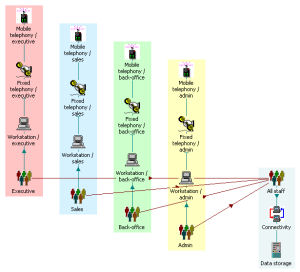 A
basic model may consider the following user requirements as services in STEM: telephony,
data transfer, data storage, applications, desk space, admin facilities and office
space. Telephony may be a combination of fixed and mobile, or migration from
traditional to VoIP.
A
basic model may consider the following user requirements as services in STEM: telephony,
data transfer, data storage, applications, desk space, admin facilities and office
space. Telephony may be a combination of fixed and mobile, or migration from
traditional to VoIP.
Mobile broadband is likely to become a more significant factor for itinerant staff,
and potentially all staff if flat-rate data plans and performance make this an attractive
universal solution for all employees, especially of SMEs.
A more detailed model may consider: helpdesk support, call centre support, managed
services, project management services and hosting services (data centre or office
space), and may compare technical design and innovation ideas, application optimisation
designs and techniques.
 On
the cost side, specific ICT resources which fulfil the requirements of these services
are enumerated in the simplest configuration and calibrated for capacity, lifetime
and unit cost.
On
the cost side, specific ICT resources which fulfil the requirements of these services
are enumerated in the simplest configuration and calibrated for capacity, lifetime
and unit cost.
An initial working set of resources would include:
- mobile phones and mobile minutes
- feature phones, PABX, external lines and fixed minutes
- IP phones, VoIP server/gateway and VoIP minutes
- LAN hubs, switches, routers, cabling and wiring
- desktop PCs, laptops, peripherals and software licences
- printers, servers, content switches and storage
- desks and office space
- WAN bandwidth and lines.
This may be further extended to cover the following headings:
- portable email or applications devices
- office / server / data-centre space
- power
- videoconferencing facilities
- mainframes
- network management centres
- enterprise software products and databases
- firewalls and security-based products.
Perhaps the biggest challenge for such a model is to frame a generic ICT structure
which can be readily related to a range of real-life situations.
Typical user profiles
Of course, the reason to model the different classes of ICT users separately is
to capture their distinct usage patterns, and to measure the impact of changes in
these patterns on the underlying infrastructure. A change in ICT strategy
may be just as likely to come about as a reaction to changing employee demographics
as to developments in technology.
Our initial prototype has four classes of user with varying ICT needs as follows.
User profiles for telephony and computing
|
User
|
Telephony
|
Computer
|
Applications
|
|
Executive
|
Medium minutes, mostly mobile.
|
Laptop. Probably compact. Upgraded every year. Must have portable
email device.
|
Standard office software.
|
|
Sales
|
Intensive, mostly mobile. Requires sub-model for split by destination (long
distance, international, etc.)
|
Laptop. Fine-tuned for slick presentations and reliable hotel comms.
Replaced every two years.
|
Standard office software.
|
|
Back-office
|
Low minutes. Mostly fixed.
|
Even split between high-end desktops (for number crunchers) and laptops. Replaced
every two years.
|
Increased storage, specialist application licences such as CAD or STEM.
|
|
Admin
|
Medium minutes. Mostly fixed.
|
Mostly desktops, except for executive PAs. Replaced every three years.
|
Standard office software.
|
The numbers of each class of user, as well as the quantitative aspects of their
profile, are all parameters of the model which may be tuned to a particular enterprise
situation. Additional profiles may be readily added to this mix.
A total staff element may be used as a simple driver for common requirements such
as a desk and office space. However, this is little more than a way to get
started. Pretty soon it will become clear that even the type of desk and office
space may vary between users (e.g. executive vs admin). In fact, it may be
dangerous to assume that any elements ay be considered common!
Aggregation across sites and overall aggregation for WAN bandwidth
Once we have established a reasonably generic ICT framework which represents the
users and infrastructure of an idealised business site, we are then well placed
to use STEM’s template replication functionality to create a detailed model of a
multi-site enterprise. By defining the basic model as a template and then
identifying specific parameters of that template which may vary by site, we get
all the benefits of modelling each individual site without the pain of having to
create and maintain all the detailed calculation structure n times over.
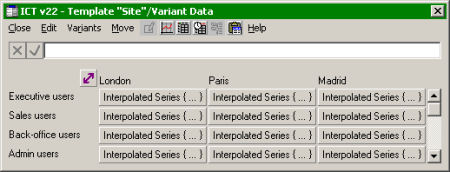
Numbers of users by class and site
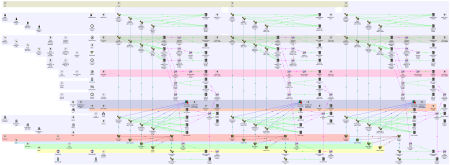
Replicated model structure across multiple sites
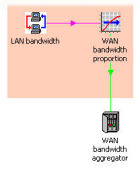 A
transformation within the template identifies the proportion of bandwidth arising
at each individual site which is routed externally. This in turn drives a
single bandwidth aggregator outside of the template which dimensions the required
bandwidth for the managed inter-site WAN.
A
transformation within the template identifies the proportion of bandwidth arising
at each individual site which is routed externally. This in turn drives a
single bandwidth aggregator outside of the template which dimensions the required
bandwidth for the managed inter-site WAN.
Current and future technology configuration
There are almost limitless possibilities for new technology scenarios which may
be suggested, or which my arise in the course of developing this model. For
example, one might consider a traditional IT infrastructure, and potential migrations
to IP telephony, managed communications or managed facilities. One dimension
describes the current setup and a second specifies a future migration. Obviously
one only wants to consider ‘forward’ migrations, as shown below.

Scenarios for various forward technology migrations
Alternatively, one might look more closely at the split between traditional telephony
and VoIP, or the gradual move towards an increasingly mobile workforce.

Scenarios for fixed and mobile telephony
To be continued…
The ideas expressed above are intended as little more than an outline of the shape
of a model which we will build in-the-round with our customers at the STEM User
Group Meeting in September. Although the experience will be somewhat hair-raising
for the seasoned consultants who will lead the proceedings, past experience gives
us full confidence that the modelling objectives can be met within the 48 hours
available, thanks both to the wide range of intellect and experience present and
to the clarity of the iconic modelling interface which so positively aids group comprehension
during this kind of workshop.
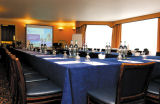 Please
send us your comments and suggestions in advance, and
register for the event if you have not already done so.
Please
send us your comments and suggestions in advance, and
register for the event if you have not already done so.